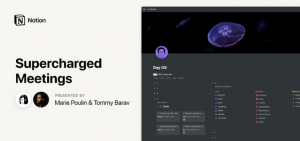Did you know that roughly two-thirds of the population are visual-spatial learners?
I definitely count myself among this majority, which means I often need to see information presented visually in order to truly comprehend it.
For many years, this is how I made my living: mapping out experiences, funnels, products, business models, etc, and then helping people use technology to bring their processes and designs to life.
When I stumbled upon this tweet, I was all YESSSSS SOPs!!!:
… except for that part about Google Drive and Dropbox.
Getting a content library for your documentation is a good start, but folders don’t quite cut it (for most of us).
(Sorry Cam! It’s ok though, he agreed and said just looking at my Operations dashboard made him happy!)
While *Notion does have a learning curve when you’re using it as an all-in-one tool (task management, journaling, project planning, documentation, etc), it is without a doubt the best/easiest place to keep your documentation and standard operating procedures.
My Operations hub is one of my favourite Notion pages. It’s beautiful, it’s practical, and most importantly, it’s USABLE. I know where everything lives, and so does my assistant.
Nearly all of the workflow pages have an embedded Whimsical map with links to all of the appropriate technology. The icons along with the columns and headers help me find information quickly, and everything I need is 1 or 2 clicks away at any time.
I can share individual pages with contractors or additional team members, giving permission to all or only some of the pages.
Tell me this isn’t a more visually inspiring (and practical) experience than a folder system in Google Drive?
👉🏼The Operations page (and nearly every other page you’ll ever find in my workspace) can be found inside Notion Mastery. Anytime I make an addition or revamp my space, I always include it in the course, so students always have access to the most up-to-date templates.
Many of us think of Google Docs as being ubiquitious and easy to use because “everyone’s got a google account,” and this is somewhat true. HOWEVER. In my experience, most people I work with are much more eager to get their documentation in place when they start using Notion.
They’re way more inspired, and they actually follow through on using it.
But their Google Drives?
Let us not speak of it.
I know I’m more likely to use my workspaces because I enjoy using them. I use images that inspire me, AND information is displayed in ways that feel good to my brain.
Technology has the ability to influence how we feel, and Notion is a blank canvas of possibility. I like to wield its power for good, designing spaces that make me feel calm, inspired, or focused (depending on the use case).
My FOCUS dashboard for example is very simple, and only includes the most important information I want/need to see when I need to get focused and reduce any distractions whatsoever.
Making things more aesthetically pleasing isn’t necessarily a frivolous activity. Tiny details like those little tomato/pomodoros? Gosh darnit they make my garden-loving heart sing AND they help me quickly see how long something is going to take.
You can have beautiful AND functional.
You know who elses workspaces are aesthetic and usable? Frances Odera Matthews. Her spaces gorgeous, and she gave us some tips on how to make your space both aesthetically pleasing and usable on this episode of Office Hours.
You can catch the replay here:
You can also drool over her work at https://thenotionbar.com/ or on Twitter.
[For full disclosure, I’m a *Notion Partner, so when you sign up with my link, you also help support me and my content!]



Leave a Reply